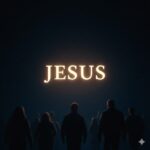“New Testament Giants of the Faith – Thomas?” – John 20:19-31
Introduction: New Testament Giants of the Faith
Today I am starting a little series of sermons during this Easter season on some New Testament Giants of the Faith. There are probably more Old Testament Giants of the Faith – guys like Noah, Abraham, Jacob, Moses, Ruth, Esther, David, Elijah, and more. But during the Easter season, our usual Old Testament reading is replaced by a reading from the Book of Acts, and four of the characters kind of stand out in either those Acts readings or in the Gospel readings… so here we go… with Thomas, Paul, John and Peter. Thomas?? A New Testament Giant of the Faith? Really? Come on, pastor… maybe a New Testament Giant of Doubt! But faith?? Well, let’s consider his story, and see what Thomas is all about, and what impact he has on us.
1. Who is Thomas?
First of all, you may be quite unfamiliar with Thomas. That’s because he is mentioned only 8 times in the New Testament. In four of those times, Thomas’ name is simply mentioned along with the others in a list of the disciples. Those lists are found as Jesus called and gathered the Twelve disciples in Matthew 10, Mark 3 and Luke 6. Then in Acts 1, after Jesus had ascended, there is another list which, of course, does not include Judas. In those lists, Peter, Andrew, James and John are always the first four. They seem to be the most prominent disciples, the ones we hear about the most during Jesus’ ministry. Thomas is named 6th, 7th, and twice he is named 8th, which tells us that he is neither the most important nor the least important of the Twelve… solidly in the middle.
The other 4 occurrences of Thomas are all in the Gospel of John. In John 21:2 Thomas is 2nd in a listing of 7 disciples who went out night-fishing after the resurrection. In that story, and in two of the other ones, Thomas is also identified as “Didymus” or “the twin,” although we don’t hear anything more about the other twin or the significance of that designation. In John 21, the disciples didn’t catch any fish all night, but when a man on the shore told them to throw their net on the right side of the boat, they caught a net-full of fish. John recognized that it was Jesus, Peter jumped in the lake and swam ashore, and there Jesus was… cooking breakfast on the beach – some fish and bread. Thomas was part of that experience, but he plays no significant part in it. He says nothing. So, let’s direct our attention to the other 3 stories where Thomas actually says something.
2. Thomas in John 11
John 11 records the episode of Jesus raising Lazarus back to life after a four-day long stay in the tomb. Mary and Martha had sent word from Bethany to Jesus (wherever He was at the time) that their brother was sick. Jesus didn’t immediately travel to Bethany to heal Lazarus, but after a couple of days He said to the disciples, “Let’s go back to Judea.”
His disciples reminded Him of the pending danger: “A short while ago… check it out, Jesus, just 20 verses back, in chapter 10… the Jews were going to stone you. You want to go back there?? You’re going to get yourself, and us, into trouble, big trouble!!”
In His somewhat hidden response, Jesus taught them that as long as He, the light of the world, was among them they were safe. Then, in another somewhat hidden figure of speech, He said that Lazarus was asleep, and that He would go to wake Him up. The disciples didn’t get it, so Jesus finally explained plainly that Lazarus was dead. At that point, He said, “Let’s go!”
Enter Thomas! Speaking to the rest of the disciples, who may have been fearful and cautious about going back anywhere near Jerusalem, Thomas said, “Let us also go, that we may die with Him.” So, those are the first words of Thomas in the Gospel of John. Do they indicate confusion and misunderstanding on Thomas’ part, or clarity and insight? After all, Jesus clearly said that the purpose in His going to Judea was to wake up, to raise up, Lazarus from death. And that is the meat of the rest of the chapter – including Jesus’ compassion in the shortest verse in the Bible – Jesus wept – and His powerful statement “I AM the Resurrection and the Life.”
Where would Thomas get the idea of Jesus dying, and of the disciples dying with Him? Perhaps it was from that previous episode in John 10 of the Jews intending to stone Him to death. And if that intention was not still real and relevant, by the time we get to the end of John 11, after Jesus had raised Lazarus, we hear about the plot to kill Jesus intensifying with the statement of Caiaphas, the high priest: “Don’t you realize that it is better for you that one man die for the people than that the whole nation perish?” The writing was on the wall. Jesus was going to die. From that day on they plotted to take His life.
Thomas’ statement – “Let’s go that we may die with Him.” – seems to indicate some skewed impression of their immanent travel plans. Jesus said He wanted to go to raise Lazarus up from death, and Thomas is talking about laying down with Jesus in death. That’s not quite right, Tom!
But on the other hand, there is a deep understanding of Jesus’ ultimate reason and purpose for going to Jerusalem. If Jesus is going to Judea to face potential death, then Thomas is all in. The love in Thomas’ heart for His rabbi and Master gives Him courage and makes Him ready to go all the way to death for and with Jesus. Peter said something similar just after Jesus ate the Last Supper with His disciples: “Lord, I am ready to go with you to prison, and to DEATH!!” So, Thomas’ words and boldness weren’t out of place. He was fiercely committed to His Lord.
Just to give some context, at the end of John 11 people were already going up to Jerusalem for the Passover festival. John 12 introduces Holy Week – with Jesus back at the home of Mary, Martha and Lazarus again. Then we read about Jesus’ triumphal entry into Jerusalem on Palm Sunday and another prediction of His death. Then John 13 is Maundy Thursday with Jesus washing the feet of His disciples, and His command to love one another. Jesus’ crucifixion would happen the very next day. So, “let us go to die with Him” was a very intuitive statement that Thomas spoke.
3. Thomas in John 14
As we jump ahead to John 14, Thomas’ name and voice appear again. Jesus is consoling the disciples: “Don’t let your hearts be troubled… I’m going to prepare a place for you in my Father’s house. You know the way…”
He had told them several times before that He would be turned over to the chief priests who will mock, flog and kill Him. The disciples never seemed to truly understand that, but if they did now, Jesus wanted to calm their anxious and fearful hearts. It’s when Jesus says that they know the way to the place where He is going that Thomas begins to think, and wonder. What is Jesus talking about? Perhaps Thomas began to scour his memory banks to determine if Jesus had said anything about another destination, and about the way, the road, to get to that next town. So, he blurts out what was probably on the mind and the lips of every other disciple: “Lord, we don’t know where You are going, so how can we know the way?” It would be like asking Google for directions without plugging in a destination.
Thomas and the others had been with Jesus for some three years. They had listened to Him speak about the Kingdom of God on many occasions. They had seen Him heal people, and cast demons out of people, and do miracles. Yet here, representing all the disciples, Thomas expresses his ignorance, and betrays the fact that they still understand little or nothing of Christ’s words and mission. In fact, so firmly were their hearts and minds set on the matters of this world and of a political or military Messiah who would restore the glory and might of Israel that they could not understand Jesus’ references to a place and a way. So, yes… Thomas protests that they know neither the object nor the goal of Jesus’ going, and so obviously they don’t know the way.
But thankfully Thomas’ ignorance leads Jesus to state one of His seven “I AM” statements, and a memorable one at that. “I AM the Way, and the Truth and the Life. No one comes to the Father except through Me.” Jesus points to the destination – the Father, and the Father’s house. And He clarifies that He, Himself, is the Way. Martin Luther, in a sermon on John 14, writes: “[Jesus’] object is to tie and to bind [the disciples] completely to Himself alone with their eyes, ears, and hearts, so that they will not see and think beyond Him. He says… ‘Thomas, where are your eyes and your thoughts? One must not speculate and flit about this way. Look here at Me. Surely you know Me. And if you know and see Me, then you also know and see the way, and you must not worry any longer.’”
The disciples actually knew, but they didn’t know that they knew. Sorrow and threats deadened their spiritual faculties. So, Jesus teaches them…
He is the Way to God and to heaven. He carries those who trust in His name. He brings them safely to the home above.
He is the Truth. His every word may be trusted implicitly, for it teaches the knowledge of God and directs the way, the right way.
He is the Life. He is the fountain of all true life. He gives life to all those who believe in Him, and that is a life that is to be enjoyed eternally.
4. Thomas in John 20
And that brings us to the most famous Thomas passage in the Bible, the one which gave him the derogatory nickname, “Doubting Thomas.” We have heard the first appearance of the risen Jesus to the disciples in the Upper Room on Easter evening. He conveyed His very peace on them. But Thomas must have been having an Easter dinner with his family, because he wasn’t there. Oh, wait… they didn’t really know it was Easter yet!!
But during the week, the disciples couldn’t hold in their joy and excitement. “We have seen the Lord,” they told Thomas. But the scientist in Thomas, the skeptic in Thomas, wouldn’t allow him to believe until he saw the risen Jesus with his own eyes and until he experienced the risen Jesus with his own hands. You see, the sense of sight might be an illusion. He needed to back it up with the sense of touch. Before we judge Thomas, we must consider whether we would believe that someone we last saw being lowered into a tomb would be alive and well a couple of days later. Before we judge only Thomas, we must remember that, when Jesus gave the Great Commission in Matthew 28, it is prefaced by the statement that “some doubted.” So, labelling Thomas as ‘doubting’ doesn’t take into consideration all the others who doubted, including us.
Anyway, a week later, Jesus obliged Thomas’ doubts. When the disciples were gathered for a business meeting the next Sunday night, behind the locked doors of that same Upper Room, Jesus suddenly and surprisingly stood among them. He offered the same greeting of peace that He had a week earlier. Then, complying with the very conditions as Thomas had made them, Jesus also added the sense of hearing to the mix as He said to Thomas, “See my hands, touch my side. Believe.” Thomas’ wavering faith was secured, and this week-later appearance to Thomas made him a proper witness of the resurrection.
Jesus met Thomas exactly where he needed, with a personal, and physical interaction to dispel Thomas’ doubts and to draw out his faith and his confession. His confession was strong and on point: “My Lord, and my God!” His faith now knows that his Lord and Master is alive, risen from the dead, and it also knows that He is true God – conquering even death. That is a miracle only God can perform… pulling His own life back out of death, and in doing so completing our redemption and salvation. And Thomas’ statement of faith is personal… not just “You are Lord and God,” but “You are MY Lord and MY God!” Jesus’ follow-up response speaks to our reality – that we who believe without having personally and with our own eyes seen the risen Christ, that we who believe without having touched the wounds of His risen body… we are truly blessed!
5. Thomas for us
So, let’s consider then how Thomas is, for us, a giant of the faith.
First of all, you may feel like Thomas – he was neither the most important nor the least important of Jesus’ followers. He wasn’t the first and he wasn’t the last, but he was solidly in the middle. A lot of us can relate to that.
In the John 11 Lazarus story, Thomas demonstrated a passion for and a commitment to his Saviour beyond that of the other disciples. He was willing to go with Jesus to the possible dangers of Jerusalem, even if it meant death. He was willing to die for Jesus, and he didn’t really know that, in fact, Jesus was going to Jerusalem to die for him!! (and for us!!) How many of us are passionate enough about our Lord to make a sacrifice for Him – time, service, sacrificial offerings? How many of us are passionate enough about our Lord to die for Him? In that sense, Thomas was a giant of courage and faith and discipleship..
In the John 14 dialog between Thomas and Jesus, Thomas was humble and honest enough to candidly and openly confess his ignorance of Jesus’ meaning and intention. But that humility led to one of our most profound understandings of Jesus’ character and purpose – the Way, the Truth, and the Life. In an unsuspecting way, Thomas leads us to know that Jesus is a sure and certain way to the Father, and to the Father’s heavenly home which is being prepared for us. In that sense, Thomas was a giant of humility and honesty.
In the John 20 post-resurrection appearance of Jesus to Thomas, we are challenged to confront our own doubts, and to realize that we can stand there with the first Easter doubter and with him see and touch the risen Saviour, thereby having our doubts dispelled. We can likewise make that bold and confident confession of faith: “MY Lord and MY God!” We haven’t seen Jesus with our eyes, but we have Him seen with our hearts, and we believe. Those of us who have never seen the risen Jesus with our eyes are still able to touch His very body in the bread of Holy Communion. There, Jesus meets you exactly where you need Him to meet you… with His grace, forgiveness, love and salvation. In that sense, Thomas was a giant leading all of us from doubt to faith.
Thomas… a giant of faith? Maybe not, but a giant of real discipleship – he had his ups and downs, his uncertainties, his doubts but he also had his deep commitments and his sincere beliefs and his bold confessions. In that way, he’s a guy we can relate to. I would be honoured to have ‘Thomas’ as my middle name… maybe you would, too. Let’s pray…









